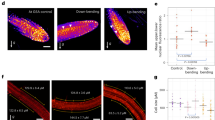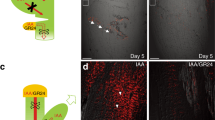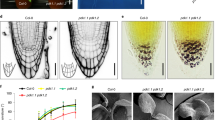Abstract
Many aspects of plant growth and development are dependent on the flow of the hormone auxin down the plant from the growing shoot tip where it is synthesized1,2. The direction of auxin transport in stems is believed to result from the basal localization within cells of the PIN1 membrane protein, which controls the efflux of the auxin anion3. Mutations in two genes homologous to those encoding the P-glycoprotein ABC transporters that are especially abundant in multidrug-resistant tumour cells in animals4 were recently shown to block polar auxin transport in the hypocotyls of Arabidopsis seedlings5. Here we show that the mdr mutants display faster and greater gravitropism and enhanced phototropism instead of the impaired curvature development expected in mutants lacking polar auxin transport. We find that these phenotypes result from a disruption of the normal accumulation of PIN1 protein along the basal end of hypocotyl cells associated with basipetal auxin flow. Lateral auxin conductance becomes relatively larger as a result, enhancing the growth differentials responsible for tropic responses.
This is a preview of subscription content, access via your institution
Access options
Subscribe to this journal
Receive 51 print issues and online access
$199.00 per year
only $3.90 per issue
Buy this article
- Purchase on Springer Link
- Instant access to full article PDF
Prices may be subject to local taxes which are calculated during checkout



Similar content being viewed by others
References
Muday, G. K. & DeLong, A. Polar auxin transport: controlling where and how much. Trends Plant Sci. 6, 535–542 (2001)
Gil, P. et al. BIG: a calossin-like protein required for polar auxin transport in Arabidopsis. Genes Dev. 15, 1985–1997 (2001)
Friml, J. & Palme, K. Polar auxin transport—old questions and new concepts? Plant Mol. Biol. 49, 273–284 (2002)
Ambudkar, S. V. et al. Biochemical, cellular, and pharmacological aspects of the multidrug transporter. Annu. Rev. Pharmacol. Toxicol. 39, 361–398 (1999)
Noh, B., Murphy, A. S. & Spalding, E. P. Multidrug resistance-like genes of Arabidopsis required for auxin transport and auxin-mediated development. Plant Cell 13, 2441–2454 (2001)
Sánchez-Fernández, R., Davies, T. G. E., Coleman, J. O. D. & Rea, P. A. The Arabidopsis thaliana ABC protein superfamily, a complete inventory. J. Biol. Chem. 276, 30231–30244 (2001)
Murphy, A. S., Hoogner, K. R., Peer, W. A. & Taiz, L. Identification, purification, and molecular cloning of N-1-naphthylphthalamic acid-binding plasma membrane-associated aminopeptidases from Arabidopsis. Plant Physiol. 128, 935–950 (2002)
Sidler, M., Hassa, P., Hasan, S., Ringli, C. & Dudler, R. Involvement of an ABC transporter in a developmental pathway regulating hypocotyl cell elongation in the light. Plant Cell 10, 1623–1636 (1998)
Geldner, N., Friml, J., Stierhof, Y.-D., Jürgens, G. & Palme, K. Auxin transport inhibitors block PIN1 cycling and vesicle trafficking. Nature 413, 425–428 (2001)
Gälweiler, L. et al. Regulation of polar auxin transport by AtPIN1 in Arabidopsis vascular tissue. Science 282, 2226–2230 (1998)
Muday, G. K. Auxins and tropisms. J. Plant Growth Regul. 20, 226–243 (2001)
Friml, J., Wisniewska, J., Benkovà, E., Mendgen, K. & Palme, K. Lateral redistribution of auxin efflux regulator PIN3 mediates tropism in Arabidopsis. Nature 415, 806–809 (2002)
Harper, J. D. I. et al. A simple and rapid technique for the immunofluorescence confocal microscopy of intact Arabidopsis root tips: Localization of a centrin-like protein to higher plant plasmodesmata. Cytobios 87, 71–78 (1996)
Folta, K. M. & Spalding, E. P. Unexpected roles for cryptochrome 2 and phototropin revealed by high-resolution analysis of blue light-mediated hypocotyl growth inhibition. Plant J. 26, 471–478 (2001)
Acknowledgements
We thank K. Palme for the PIN1 antibody, M. Sussman and S. Bednarek for the AHA2 antibody, and J. Wagner for technical assistance.
Author information
Authors and Affiliations
Corresponding author
Ethics declarations
Competing interests
The authors declare that they have no competing financial interests.
Supplementary information
Rights and permissions
About this article
Cite this article
Noh, B., Bandyopadhyay, A., Peer, W. et al. Enhanced gravi- and phototropism in plant mdr mutants mislocalizing the auxin efflux protein PIN1. Nature 423, 999–1002 (2003). https://doi.org/10.1038/nature01716
Received:
Accepted:
Issue Date:
DOI: https://doi.org/10.1038/nature01716
This article is cited by
-
Identification of a candidate gene controlling semi-dwarfism in watermelon, Citrullus lanatus, using a combination of genetic linkage mapping and QTL-seq
Horticulture, Environment, and Biotechnology (2021)
-
Fine mapping and discovery of candidate genes for seed size in watermelon by genome survey sequencing
Scientific Reports (2018)
-
A transportome-scale amiRNA-based screen identifies redundant roles of Arabidopsis ABCB6 and ABCB20 in auxin transport
Nature Communications (2018)
-
Phototropism in land plants: Molecules and mechanism from light perception to response
Frontiers in Biology (2018)
-
Regulation of seedling growth by ethylene and the ethylene–auxin crosstalk
Planta (2017)
Comments
By submitting a comment you agree to abide by our Terms and Community Guidelines. If you find something abusive or that does not comply with our terms or guidelines please flag it as inappropriate.



